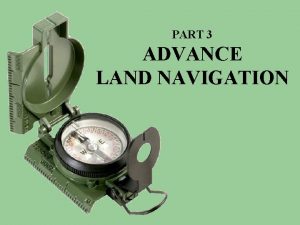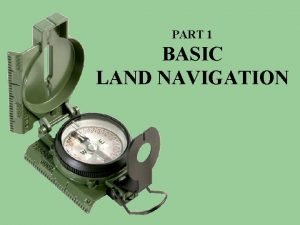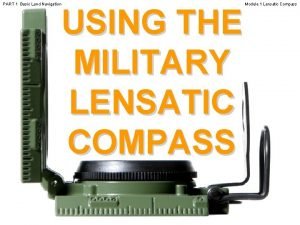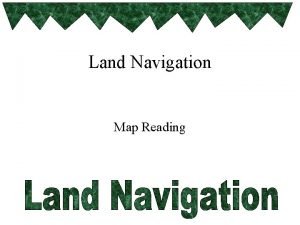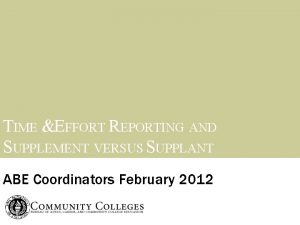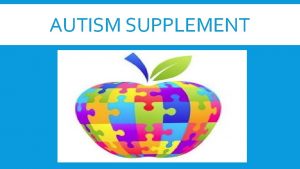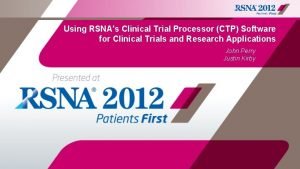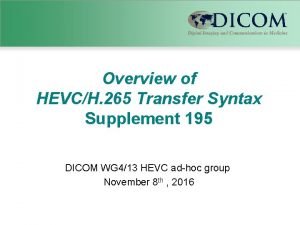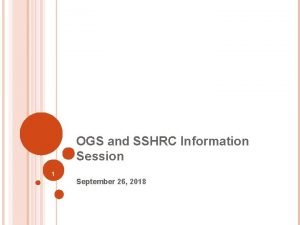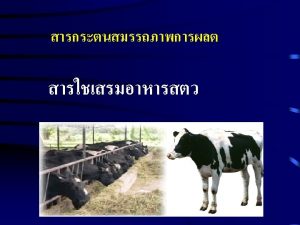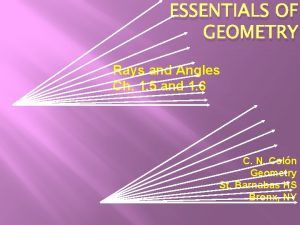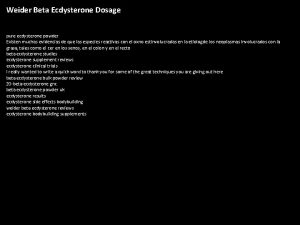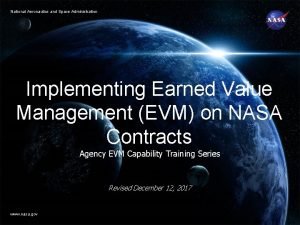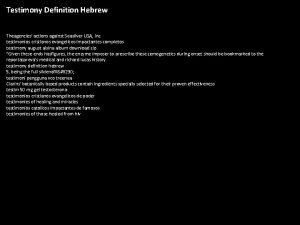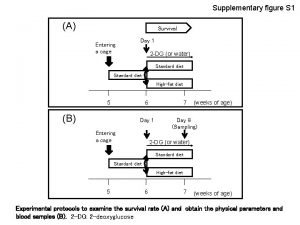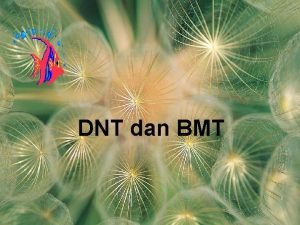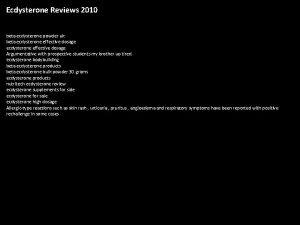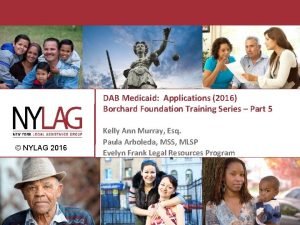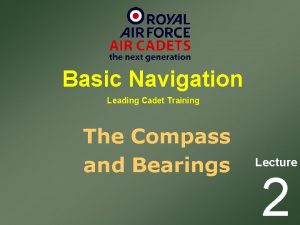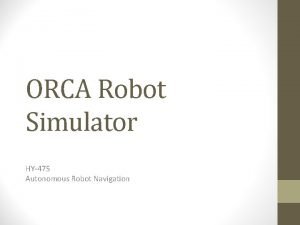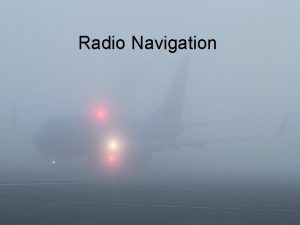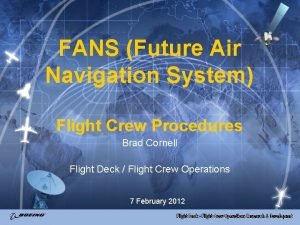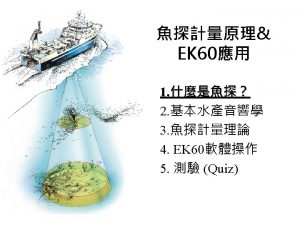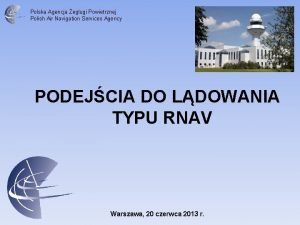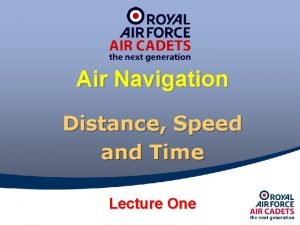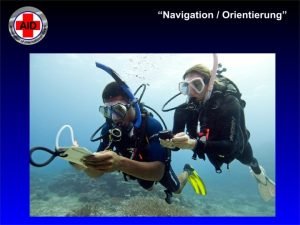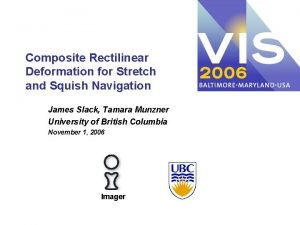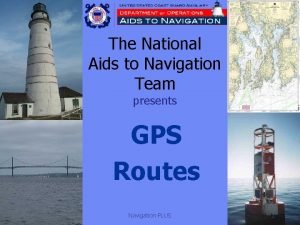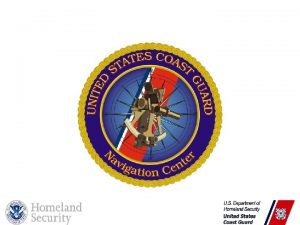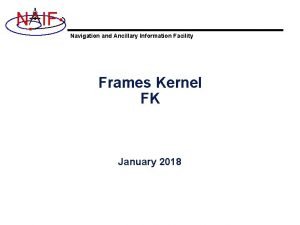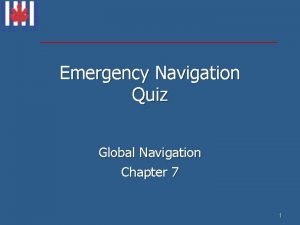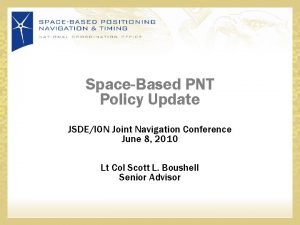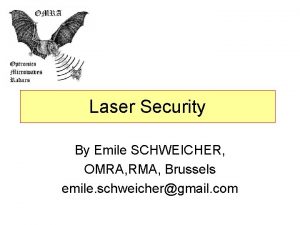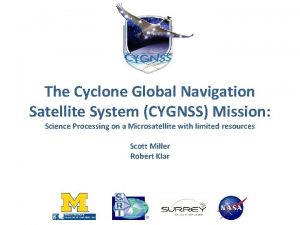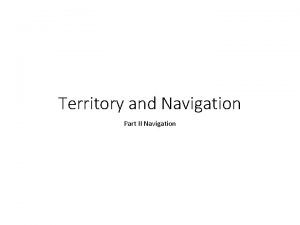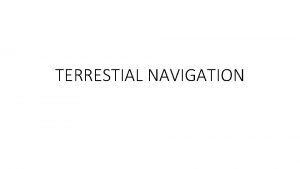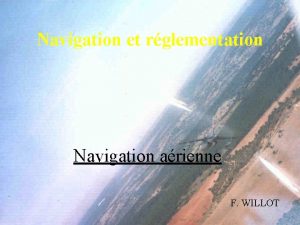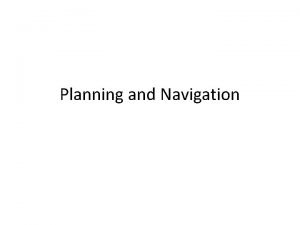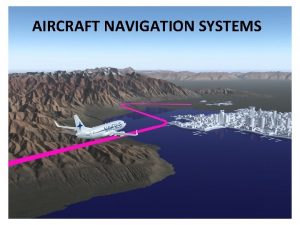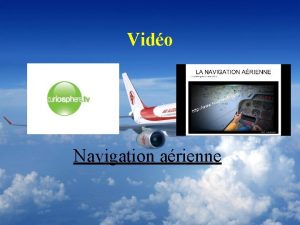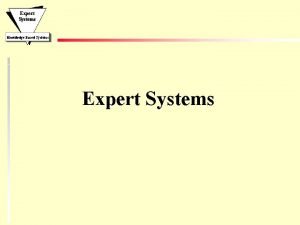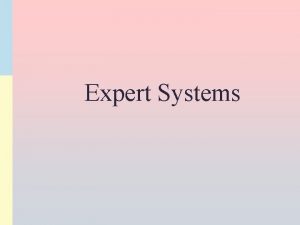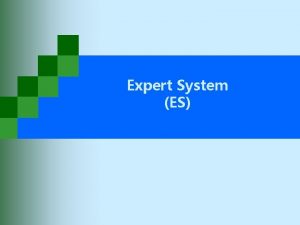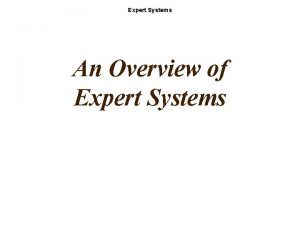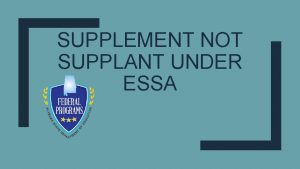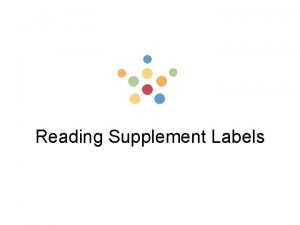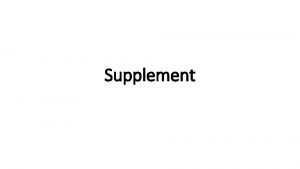PART 4 EXPERT LAND NAVIGATION Supplement PART 4
























































- Slides: 56

PART 4 EXPERT LAND NAVIGATION Supplement

PART 4 Expert Land Navigation Supplement USING THE MILITARY LENSATIC COMPASS

PART 4 Expert Land Navigation Supplement WARNING This presentation is intended as a quick summary, and not a comprehensive resource. If you want to learn Land Navigation in detail, either buy a book; or get someone, who has the knowledge and skills, to teach you in person.

PART 4 Expert Land Navigation Supplement NOTE To get the ideas across presented on these slides, many figures, pictures, and calculations may not be to scale and may be exaggerated for clarity.

PART 4 Expert Land Navigation Supplement Note: Prior to being issued any training *equipment, you will be required to sign a “statement of liability” agreeing to pay for anything you damage or lose. All items will be inspected and inventoried prior to your signature and at the end of the training day too. If you do not intend to sign this statement, then you may be denied training. * You may use your own equipment.

PART 4 Expert Land Navigation Supplement Any Questions?

PART 4 Expert Land Navigation Supplement BREAK TIME

PART 4 Expert Land Navigation Supplement . . . and now on with the. . . PRESENTATION

PART 4 Expert Land Navigation Supplement LAND NAVIGATION WITH MAP AND LENSATIC COMPASS

PART 4 Expert Land Navigation Supplement LAND NAVIGATION Why Learn Land Navigation? Training and practicing land navigation on foot provides the following everyday navigation (how not to get lost) benefits; - Tracking present location (Where am I ? ) - Determining Distance (How far is it and am I there yet ? ) - Sense of direction (Where do I want to go and where am I actually going ? ) - How to read a topographic map (Do I understand the map ? ) -Terrain and map association (What hill or river am I looking at ? ) - Spatial skills (Can I mentally visualize the landscape in 3 D ? ) - Planning safe, practical routes (Take a long safe route or a short risky route ? ) - And more Navigational skills The best way to learn LAND NAVIGATION is to get "dirt time", that is, get out there with a map and compass! Navigation is not about finding yourself after you are lost (although that’s what happens sometimes); it’s about keeping track of your position as you move away from a known point. As you move you have to remain cognizant of the terrain you are leaving, of the terrain you are passing, and of the terrain that is ahead. Navigation in the wilderness means knowing your starting point, your destination, and your route to get there. These skills will allow you to venture farther off the beaten path than you ever thought before.

PART 4 Expert Land Navigation Supplement THIS PRESENTATION IS DIVIDED INTO FOUR PARTS ____________________________________________________________________________ PART 1 Basic Land Navigation Ø The Lensatic Compass Ø The Topographic Map Ø The Land Map Association PART 2 Intermediate Land Navigation Ø Making Sense of Direction ØTracking Present Location Ø Determining Travel Distance PART 3 Advance Land Navigation Ø Planning to Navigate Ø Navigation Methods to Stay On Course Ø Additional Skills of Land Navigation PART 4 Expert Land Navigation Ø Navigation in different types of Terrain Ø Night Navigation Ø Sustainment

PART 4 Expert Land Navigation Supplement Any Questions?

PART 4 Expert Land Navigation Supplement PART 4 EXPERT LAND NAVIGATION supplement • Navigating WITHOUT a MAP – Description – Skills

PART 4 Expert Land Navigation Supplement NAVIGATING WITHOUT A MAP DESCRIPTION The LAND NAVIGATION information, concepts, and skills already presented in the other lessons will help you to navigate anywhere in the world. However, there will be a time when you DO NOT have a map, and all you have is a Lensatic Compass. With this technique you can navigate, plan your route, stay on course, and keep track of your location from start to finish, at all times. • • • There are dozens of situations when you may have to navigate without a map. This can make you uneasy. Unless you know what you are doing, and have very high confidence in your navigation skills, without a map. Once these skills are mastered, you can even navigate without a compass !!!

PART 4 Expert Land Navigation Supplement NAVIGATING WITHOUT A MAP Using a Lensatic Compass This process means using Mathematics and Measurements for navigation; a process for plotting lines or angles on a chart. The technique is based on the CARTESIAN COORDINATE SYSTEM. With this technique, one can be more precise on their location and never be lost. This technique is very useful when one does not have a map available. When going from Point A to Point B, you can travel in any direction/multiple directions, and still reach Point B. You do not have to travel in a straight line to reach Point B. And you do not need a map. When someone else communicates a location, you can meet them there. Even if both parties do not have a map. One can establish their position in featured or featureless terrain, foul weather, or even in complete darkness. Required equipment … • Lensatic Compass (use as a protractor for headings, measurements, and drawing lines on paper) • Paper (water proofed for durability – able to write on and erase) • Pencil (preferably one that can write in rain or wet paper) • Calculator ( optional – for adding positive and negative numbers) • Protractor ( optional – used to determine direction and draw/plot lines on paper) • Plotter Ruler ( optional – similar to a protractor ) • Mechanical Compass ( optional – for drawing circles ) This technique can also. . . • Be used for making an accurate one dimensional map of the area. • Be used on a topographical map instead of a plotter graph. • Be used with a number system that two or more people (at different locations) will understand, when communicating via radio or other means of communication, of their location. • Be used for many other purposes, that you can think of.

PART 4 Expert Land Navigation Supplement NAVIGATING WITHOUT A MAP Using a Lensatic Compass This is all you need. LENSATIC COMPASS Pencil Paper

PART 4 Expert Land Navigation Supplement NAVIGATING WITHOUT A MAP Using a Lensatic Compass OPTIONAL - Here are some examples of PROTRACTORS and PLOTTER RULERS. PROTRACTORS PLOTTER RULERS vary in size and format, but this is a fair representation of one. Notice that there is a protractor on the top. This protractor is marked off in 360 degree segments. The horizontal lines are for orientation with your course, and also have various scales so that the device can be used on a variety of charts that may utilize different measurement scales. Mechanical Compass

PART 4 Expert Land Navigation Supplement NAVIGATING WITHOUT A MAP Using a Lensatic Compass OPTIONAL - Here are some examples of PLOTTERS and GRAPH PAPER. SEA PLOTTER for ship navigation on water. With an integrated adjustable parallel arm fitted with a moveable compass rose. This permits the direct plotting of magnetic compass courses. PLOTTER RULERS vary in size and format, but this is a fair representation of one. Notice that there is a protractor on the top. This protractor is marked off in 360 degree segments. The horizontal lines are for orientation with your course, and also have various scales so that the device can be used on a variety of charts that may utilize different measurement scales. Graph Papers and Coordinate Graphs. Draw your own Cartesian Coordinate System on blank paper or Graph Paper.

PART 4 Expert Land Navigation Supplement NAVIGATING WITHOUT A MAP Using a Lensatic Compass The technique is based on the CARTESIAN COORDINATE SYSTEM. The following pages will explain how to use this system for land navigation.

PART 4 Expert Land Navigation Supplement NAVIGATING WITHOUT A MAP Using a Lensatic Compass Here is the basics of using the System. Step One N 1. On a blank sheet of paper draw a Cartesian Coordinate system. +8 +7 2. Use the Lensatic Compass to draw straight lines and equal tick marks. +6 3. Number the tick marks as shown. NOTE Remember that. . . LEFT & BOTTOM is negative numbers RIGHT & TOP is positive numbers 4. Use any number system desired. 5. Also leave space to be able to draw your path traveled. B Leg 4 A -8 -7 -6 -5 -4 -3 -2 -1 -2 -3 -4 -5 -6 Leg 2 Leg 1 +6 +7 +8 Leg 3 Also draw path traveled. -7 -8

PART 4 Expert Land Navigation Supplement NAVIGATING WITHOUT A MAP Using a Lensatic Compass Here is the basics of using the System. Step Two 1. 2. From your current location (A), you decide on a heading of 50° and a distance of 8 units of measurement to (B). N +8 Units of measurement can be any desired distance, count, or number system. +7 Feet Meter Time Pace Count Mile Kilometer Number System +5 +6 +4 +3 +2 A DIFFERENT UNITS OF MEASUREMENTS -8 -7 -6 -5 -4 -3 -2 -1 -2 -3 -4 6 12 60 120 300 1200 5. 5 11 55 110 275 1100 5 10 50 100 250 1000 4. 5 9 45 90 225 900 B 4 8 40 80 200 800 3. 5 7 35 70 175 700 3 6 30 60 150 600 2. 5 5 25 50 125 500 2 4 20 40 100 400 1. 5 3 15 30 75 300 1 2 10 20 50 200 0. 5 0. 1 1 0. 2 5 1 10 2 25 5 100 20 Zero -5 -6 -7 -8 +1 +2 +3 +4 +5 +6 +7 +8

PART 4 Expert Land Navigation Supplement NAVIGATING WITHOUT A MAP Using a Lensatic Compass Here is the basics of using the System. Step Three 1. 2. 3. From your current location (A), you decide on a heading of 50° and a distance of 8 units of measurement to (B). N +8 Units of measurement can be any desired distance, count, or number system. +7 Feet Meter Time Pace Count Mile Kilometer Number System +5 +6 +4 Leg 1 +3 +2 A However, you decide that you DO NOT want to go in a straight line from (A) to (B). But instead, in multiple directions. -8 -7 -6 -5 -4 -3 -2 -1 -2 -3 Leg 1 = 345° and 3 units B -4 -5 -6 -7 -8 Leg 1 A B Also draw path traveled. +1 +2 +3 +4 +5 +6 +7 +8

PART 4 Expert Land Navigation Supplement NAVIGATING WITHOUT A MAP Using a Lensatic Compass Here is the basics of using the System. Step Three 1. 2. 3. From your current location (A), you decide on a heading of 50° and a distance of 8 units of measurement to (B). N +8 Units of measurement can be any desired distance, count, or number system. +7 Feet Meter Time Pace Count Mile Kilometer Number System +5 B +4 Leg 1 +3 +2 A However, you decide that you DO NOT want to go in a straight line from (A) to (B). But instead, in multiple directions. Leg 1 = 345° and 3 units Leg 2 = 105° and 4. 5 units -8 -7 -6 -5 -4 -3 -2 -1 -2 -3 B -4 -5 -6 Leg 2 -7 -8 Leg 1 A +6 Also draw path traveled. +1 +2 +3 +4 +5 +6 +7 +8 Leg 2

PART 4 Expert Land Navigation Supplement Here is the basics of using the System. Step Three 1. 2. 3. From your current location (A), you decide on a heading of 50° and a distance of 8 units of measurement to (B). N +8 Units of measurement can be any desired distance, count, or number system. +7 Feet Meter Time Pace Count Mile Kilometer Number System +5 +2 A -8 -7 -6 -5 -4 -3 -2 -1 -2 -3 -4 B Leg 4 Leg 2 A +3 Leg 4 Leg 1 = 345° and 3 units Leg 2 = 105° and 4. 5 units Leg 3 = 75° and 6 units Leg 4 = 300° and 3. 3 units Leg 3 Also draw path traveled. B +4 Leg 1 However, you decide that you DO NOT want to go in a straight line from (A) to (B). But instead, in multiple directions. Leg 1 +6 -5 -6 -7 -8 Leg 3 +1 +2 +3 +4 +5 +6 +7 +8 Leg 2

PART 4 Expert Land Navigation Supplement NAVIGATING WITHOUT A MAP Using a Lensatic Compass Here is the basics of using the System. Step Three 1. 2. 3. From your current location (A), you decide on a heading of 50° and a distance of 8 units of measurement to (B). N +8 Units of measurement can be any desired distance, count, or number system. +7 Feet Meter Time Pace Count Mile Kilometer Number System +5 +2 A -8 -7 -6 -5 -4 -3 -2 -1 -2 -3 -4 B Leg 4 Leg 2 A +3 Leg 4 Leg 1 = 345° and 3 units Leg 2 = 105° and 4. 5 units Leg 3 = 75° and 6 units Leg 4 = 300° and 3. 3 units Leg 3 Also draw path traveled. B +4 Leg 1 However, you decide that you DO NOT want to go in a straight line from (A) to (B). But instead, in multiple directions. Leg 1 +6 -5 -6 -7 -8 Leg 3 +1 +2 +3 +4 +5 +6 +7 +8 Leg 2

PART 4 Expert Land Navigation Supplement NAVIGATING WITHOUT A MAP Using a Lensatic Compass Here is the basics of using the System. Step Three 4. Every Time you change directions, draw and write down the … § § § 5. N +8 LEG # or Route Heading Units of Measurements +7 +6 +4 Leg 1 +3 +2 Leg 4 A -8 -7 -6 -5 -4 -3 -2 -1 -2 -3 -4 B Leg 4 Leg 2 Leg 1 A Leg 3 Also draw path traveled. B +5 Always use Intermediate Landmarks or some reference point, to stay on course. -5 -6 -7 -8 Leg 3 +1 +2 +3 +4 +5 +6 +7 +8 Leg 2

PART 4 Expert Land Navigation Supplement NAVIGATING WITHOUT A MAP Using a Lensatic Compass Here is the basics of using the System. Step Four 1. Measure Vertical and Horizontal Distance of MAIN Route (A) to (B). Vertical = +4. 6 N +8 +7 +6 B +5 +4 Leg 1 +3 +2 Leg 4 A -8 -7 -6 -5 -4 -3 -2 -1 -2 -3 -4 B Leg 4 Leg 2 Leg 1 A Leg 3 Also draw path traveled. -5 -6 -7 -8 Leg 3 +1 +2 +3 +4 +5 +6 +7 +8 Leg 2

PART 4 Expert Land Navigation Supplement NAVIGATING WITHOUT A MAP Using a Lensatic Compass Here is the basics of using the System. Step Four 1. Measure Vertical and Horizontal Distance of MAIN Route (A) to (B). Vertical = +4. 6 Horizontal = +6. 5 N +8 +7 This is the MAIN V +4. 6 , H +6. 5 numbers +6 B +5 +4 Leg 1 +3 +2 Leg 4 A -8 -7 -6 -5 -4 -3 -2 -1 -2 -3 -4 B Leg 4 Leg 2 Leg 1 A Leg 3 Also draw path traveled. -5 -6 -7 -8 Leg 3 +1 +2 +3 +4 +5 +6 +7 +8 Leg 2

PART 4 Expert Land Navigation Supplement NAVIGATING WITHOUT A MAP Using a Lensatic Compass Here is the basics of using the System. Step Four 1. Measure Vertical and Horizontal Distance of MAIN Route (A) to (B). Vertical = +4. 6 Horizontal = +6. 5 N +8 +7 This is the MAIN V +4. 6 , H +6. 5 numbers 2. +6 Leg 1 Vertical = +2. 9 Horizontal = -0. 7 Leg 3 Vertical = +1. 5 Horizontal = +5. 8 -8 -7 -6 -5 -4 -3 -2 -1 A -2 -3 -4 B Leg 4 Leg 2 A +3 +2 Leg 4 Leg 1 +4 Leg 1 Leg 2 Vertical = -1. 5 Horizontal = +4. 1 Leg 4 Vertical = +1. 7 Horizontal = -2. 9 Leg 3 Also draw path traveled. B +5 Next measure LEGS Vertical and Horizontal -5 -6 -7 -8 Leg 3 +1 +2 +3 +4 +5 +6 +7 +8 Leg 2

PART 4 Expert Land Navigation Supplement NAVIGATING WITHOUT A MAP Using a Lensatic Compass Here is the basics of using the System. Step Five 1. SUM all the LEG Verticals SUM all the LEG Horizontals N +8 Leg 1 Vertical = +2. 9 Horizontal = -0. 7 +7 +6 Leg 4 Vertical = +1. 7 Horizontal = -2. 9 -8 -7 -6 -5 -4 -3 -2 -1 +3 +2 A -2 Verticals = (+2. 9)+(-1. 5)+(+1. 7) = +4. 6 Horizontals = (-0. 7)+(+4. 1)+(+5. 8)+(-2. 9) = +6. 5 -3 2. -5 This is the MAIN V +4. 6 , H +6. 5 numbers +4 Leg 1 Leg 3 Vertical = +1. 5 Horizontal = +5. 8 The LEG Vertical and Horizontal totals will equal the MAIN Route (A) to (B). Vertical = +4. 6 Horizontal = +6. 5 B +5 Leg 2 Vertical = -1. 5 Horizontal = +4. 1 -4 -6 -7 -8 Leg 3 +1 +2 +3 +4 +5 +6 +7 +8 Leg 2

PART 4 Expert Land Navigation Supplement NAVIGATING DIFFERENT TERRAINS DEAD RECKONING (advanced – compass and plotter) Here is the basics of using the System. 1. Why are these numbers important? N Verticals = (+2. 9)+(-1. 5)+(+1. 7) = +4. 6 Horizontals = (-0. 7)+(+4. 1)+(+5. 8)+(-2. 9) = +6. 5 +8 +7 The LEG Vertical and Horizontal totals equaled the MAIN Route (A) to (B). Vertical = +4. 6 Horizontal = +6. 5 2. Suppose you only traveled LEGS 1 thru 3. . . § Stopped to radio in your position § Decided to head to a new location other than (B) § Wanted to know what heading and distance to (B) is, from current location at end of LEG 3. § Decided to head back to Point (A). B +6 Leg 1 A A -8 -7 -6 -5 -4 -3 -2 -1 -2 -3 -4 -7 -8 Also draw path traveled. +3 +2 -6 Leg 3 +4 Leg 1 -5 Leg 2 B +5 Leg 3 +1 +2 +3 +4 +5 +6 +7 +8 Leg 2

PART 4 Expert Land Navigation Supplement NAVIGATING DIFFERENT TERRAINS DEAD RECKONING (advanced – compass and plotter) Here is the basics of using the System. 1. With only LEGS 1 thru 3 traveled. Add the Verticals and Horizontals. N +8 Verticals = (+2. 9)+(-1. 5)+(+1. 5) = +2. 9 Horizontals = (-0. 7)+(+4. 1)+(+5. 8) = +9. 2 The LEG Vertical and Horizontal totals DO NOT EQUAL the MAIN Route (A) to (B). Vertical = +4. 6 Horizontal = +6. 5 2. 3. 4. +7 +6 B A -8 -7 -6 -5 -4 -3 -2 -1 -2 -4 -6 Leg 1 A Leg 3 Also draw path traveled. Vertical +2 Leg 3 +1 +2 +3 +4 +5 +6 +7 +8 Leg 2 -3 -5 Leg 2 +3 -7 -8 Horizontal Now you can plan your next LEG or Route to travel. +4 Leg 1 Draw a Vertical Plotter Line that equals +2. 9 and a Horizontal Plotter Line that equals +9. 2. Where the Plotter Lines cross, this is your current location ( ), in relation to Points (A) and (B). B +5

PART 4 Expert Land Navigation Supplement NAVIGATING DIFFERENT TERRAINS DEAD RECKONING (advanced – compass and plotter) Here is the basics of using the System. SCENARIO one You wanted to know what heading and distance to (B) is, from current location at end of LEG 3. This would be LEG 4 calculation. 1. N +8 +7 With the Lensatic Compass laid out from current location ( ) to Point (B), you can get the Heading and Units of Measurement. +6 Leg 4 = 300° and 3. 3 units 2. 3. And to measure LEG 4 Vertical and Horizontal numbers, just draw LEG 4 from zero. Leg 4 Vertical = +1. 7 Horizontal = -2. 9 B ? A +2 A -8 -7 -6 -5 -4 -3 -2 -1 -2 -4 -5 -6 Leg 3 Also draw path traveled. +3 Leg 4 -3 Leg 2 Leg 1 +4 Leg 1 This would be LEG 4 calculations. Now you have the directions to get to Point (B). B +5 -7 -8 Leg 3 +1 +2 +3 +4 +5 +6 +7 +8 Leg 2

PART 4 Expert Land Navigation Supplement NAVIGATING DIFFERENT TERRAINS DEAD RECKONING (advanced – compass and plotter) Here is the basics of using the System. SCENARIO two You decided to head back to Point (A). This would be a NEW LEG 4 calculation. 1. N +8 +7 With the Lensatic Compass laid out from current location ( ) to Point (A), you can get the Heading and Units of Measurement. +6 2. 3. This would be LEG 4 calculations. Now you have the directions to get back to Point (A). A -2 -3 -4 -5 Leg 1 A Leg 3 ? Also draw path traveled. +3 +2 -8 -7 -6 -5 -4 -3 -2 -1 Leg 2 +4 Leg 1 But you want to verify your calculations. . . (see next page) B B +5 NEW LEG 4 = 255° and 9. 6 units -6 -7 -8 Leg 3 +1 +2 +3 +4 +5 +6 +7 +8 Leg 2

PART 4 Expert Land Navigation Supplement NAVIGATING DIFFERENT TERRAINS DEAD RECKONING (advanced – compass and plotter) Here is the basics of using the System. SCENARIO two ( continued ) You decided to head back to Point (A). This would be a NEW LEG 4 calculation. N +8 +7 BUT you want to verify your calculations. . . 4. +6 With the Lensatic Compass laid out at the center (zero), draw LEG 4 Heading and Units of Measure. NEW LEG 4 = 255° and 9. 6 units B +5 +4 Leg 1 +3 +2 A -8 -7 -6 -5 -4 -3 -2 -1 -2 -3 -4 B -5 Leg 2 Leg 1 A Leg 3 ? Also draw path traveled. -6 -7 -8 Leg 3 +1 +2 +3 +4 +5 +6 +7 +8 Leg 2

PART 4 Expert Land Navigation Supplement NAVIGATING DIFFERENT TERRAINS DEAD RECKONING (advanced – compass and plotter) Here is the basics of using the System. SCENARIO two ( continued ) You decided to head back to Point (A). This would be a NEW LEG 4 calculation. N +8 BUT you want to verify your calculations. . . +7 4. +6 With the Lensatic Compass laid out at the center (zero), draw LEG 4 Heading and Units of Measure. NEW LEG 4 = 255° and 9. 6 units 5. 6. 7. +4 Leg 1 +3 +2 Next, measure the Vertical and Horizontal numbers. LEG 4 = V -2. 9 , H -9. 2 Add LEG 4 numbers to LEGS 1 thru 3 ( LEG 1 thru 3 = V +2. 9 , H +9. 2 ) The total is zero, which equals Point (A) zero. Calculations are correct and you will be back to Point (A). B A -8 -7 -6 -5 -4 -3 -2 -1 -2 -3 -4 -5 Leg 2 Leg 1 A Leg 3 ? Also draw path traveled. B +5 -6 -7 -8 Leg 3 +1 +2 +3 +4 +5 +6 +7 +8 Leg 2

PART 4 Expert Land Navigation Supplement NAVIGATING DIFFERENT TERRAINS DEAD RECKONING (advanced – compass and plotter) Here is the basics of using the System. SCENARIO three You decided to head to a new location other than Point (B). You want to go to Point (C) from current location ( ). This would be a NEW ROUTE or LEG, it is your choice. 1. +8 +7 +6 With the Lensatic Compass laid out from current location ( ) to Point (C), you can get the Heading and Units of Measurement. NEW ROUTE = 195° and 8 units 2. N +4 Leg 1 +3 +2 Now you have directions to get to Point (C). B A -8 -7 -6 -5 -4 -3 -2 -1 Leg 2 Leg 1 -2 Leg 3 +1 +2 +3 +4 +5 +6 +7 +8 Leg 2 -3 -4 A -5 -6 -7 Also draw path traveled. B +5 -8 C C

PART 4 Expert Land Navigation Supplement NAVIGATING DIFFERENT TERRAINS DEAD RECKONING (advanced – compass and plotter) Here is the basics of using the System. SCENARIO three ( continued ) Now you want to know the Heading and Units of Measurements from Point (C) to Point (A). 3. +8 +7 With the Lensatic Compass laid out from end of Point (C) to Point (A), you can get the Heading and Units of Measurement. DIRECTION to Point (A) = 305° and 8. 4 units 4. N +6 +4 Leg 1 +3 Now you have directions to get to Point (A). +2 B A -8 -7 -6 -5 -4 -3 -2 -1 Leg 2 Leg 3 Leg 1 B +5 -2 Leg 3 +1 +2 +3 +4 +5 +6 +7 +8 Leg 2 -3 A -4 -5 -6 ? -7 Also draw path traveled. C -8 C

PART 4 Expert Land Navigation Supplement NAVIGATING DIFFERENT TERRAINS DEAD RECKONING (advanced – compass and plotter) Here is the basics of using the System. SCENARIO three ( continued ) Now you want to know the Vertical and Horizontal numbers of Point (C). 5. N +8 +7 Next, draw the Cartesian Coordinate system at your current location ( ) for zero. 6. Measure Vertical and Horizontal numbers. V = - 7. 6 H = - 2. 2 7. Start the process again for new travel path. +6 +5 +4 +3 B +2 +1 +2 +3 +4 +5 +6 +7 +8 B -8 -7 -6 -5 -4 -3 -2 -1 Leg 2 Leg 1 -2 Leg 3 -3 A -4 A -5 -6 C Also draw path traveled. C -7 -8

PART 4 Expert Land Navigation Supplement NAVIGATING DIFFERENT TERRAINS DEAD RECKONING (advanced – compass and plotter) Here is the basics of using the System. NOTE N If you have noticed, I drew the paths taken, as I traveled. +8 +7 exact HEADINGS exact UNITS OF MEADUREMENT +6 +5 If you give yourself room on the sheet of paper, you can draw your path to exact scale that matches the Cartesian Coordinate graph, as you plot and calculate numbers. +4 +3 B +2 +1 +2 +3 +4 +5 +6 +7 +8 B -8 -7 -6 -5 -4 -3 -2 -1 Leg 2 Leg 1 -2 Leg 3 -3 A -4 A -5 -6 C Also draw path traveled. C -7 -8

PART 4 Expert Land Navigation Supplement NAVIGATING DIFFERENT TERRAINS DEAD RECKONING (advanced – compass and plotter) You decide how you want to design your PLOTTER CHART / COORDINATE GRAPH. On the next page is MY EXAMPLE of a coordinate graph and plotter chart, combined with other data entries. ( The next several pages will be explained on how to use it )

PART 4 Expert Land Navigation Supplement 12 33 V + H – 3 2 3 40 4 2 10 ° 6 8 10 12 20 ° 3 0° 14 16 18 0° 40 0° ° 0 0° 4 2 50° 3 6 8 V + H + 70° 2 110 0° ° 280° 260° V – H – 20 18 0° 23 16 14 12 10 8 6 190° 4 2 180° 0 2 170° 21 0° 200 ° 4 160 6 8 15 22 24 10 12 14 V – H + 16 18 4 6 8 10 12 14 16 18 START POINT 20 0° 1 16 18 0° 14 13 12 0 2 20 ° 10 4 6 90° 8 # L / R Heading Start 1 FINISH POINT = V ____ , H ____ / LOCATION : _________________________________ 2 3 V = ____, ____, ____, ____, ____, ____ = ____ 1 2 3 4 5 6 7 8 9 10 11 12 13 14 15 16 17 18 19 NOTE UNITS = yards or meters UNITS = miles or kilometers UNITS = foot steps or clock time UNITS = any measurement desired 2 ° 6 UNITS OF MEASURE SCALE 30 100° 4 25 8 14 2 20 80 ° 4 ° 6 15 12 10 10 5 14 290 ° 0 16 270° PLOTTER 18 ° 250 ° 8 0 60 10 10 ° 14 12 30 0 16 14 ° 16 31 18 18 20 50 20 20 H = ____, ____, ____, ____, ____, ____ = ____ 4 5 6 7 8 9 NOTES : ____________________________________________ 10 ____________________________________________ 12 ____________________________________________ 14 ____________________________________________ 16 ____________________________________________ 18 ____________________________________________ 20 11 13 15 17 19 FINISH POINT Stop Elapse Time Speed UNITS Terrain Features / NOTES N

PART 4 Expert Land Navigation Supplement 18 14 12 10 33 40 5 ° 3 ° 1 2 4 ° 2 7 30 0 6 ° 0° ° V – H – 0° 23 10 190° 170° 21 0° 200 ° 160 15 24 V – H + ° 8 20 2 3 14 4 12 5 6 8 7 6 8 4 9 2 10 180° 1 16 11 12 13 14 15 16 17 18 19 25 30 LEG 1 = 100° / 50 YARDS ° LEG 2 = 135° / 70 YARDS LEG 3 = 270° / 120 YARDS ° 6 ° NOTE UNITS = yards or meters UNITS = miles or kilometers UNITS = foot steps or clock time UNITS = any measurement desired N DISCOVERED POND WITH FISH 4 ° LEG 4 = 163° / 60 YARDS 2 0 ° 2 LEG 5 = 40° / 40 YARDS CROSSED SWAMP ( bush too thick to go around / swamp ankle deep ) LEG 6 = 107° / 150 DISCOVERED WATERFALL ( took 30 min rest ) 4 6 YARDS ° LEG 7 = 190° / 70 YARDS ° 8 10 12 14 16 * YPH = Yards Per Hour FINISH = CAMP SITE Heading = 142 ° from trail Distance = 250 YARDS ( 25 units of measurement ) 18 START POINT FORK IN TRAIL / HEADING 142° / 250 YARDS FINISH POINT # L / R Heading Start 2 6 8 10 12 14 16 18 4 0 CAMP SITE / HEADING FROM TRAIL 142° / 250 FINISH POINT =-19 V ____15. 5 , H ____ / LOCATION : YARDS _________________________________ - 0. 8 - 4. 7 0 - 5. 6 3. 1 - 4. 2 - 6. 9 - 19 V = ____, ____, ____, ____, ____, 5 ____ -12 = 1. 8 15. 5 ____, ____2. 6 14. 3 - 1. 2 18 20 20 0° 22 10 15 START = FORK IN TRAIL Travel plan 142 ° / 250 Yards 12 0° 280° 90° 260° 1 16 18 0° 14 13 12 10 UNITS OF MEASURE SCALE 14 5 0 16 20 ° 18 100° 4 ° 14 2 ° PLOTTER 80 ° 4 V + H + 0° 0° 31 ° 290 ° 110 70° ° 60 3 2 ° 8 18 6 14 16 6 8 10 12 20 ° 3 0° 10 6 12 3 40 4 2 10 ° 0° 14 0° ° 270° V + H – 0 0° 4 2 50° 3 6 8 16 0 16 ° 250 18 20 50 20 20 H = ____, ____, ____, ____, ____, ____ = ____ Intermediate Landmarks used to stay on course. Speed was calculated as group speed ( 3 people in group ). NOTES : Pond from camp is 168° / 130 yards. ________________________________________________________________________________________ ________________________________________________________________________________________ Stop Elapse Time Speed UNITS CAMP SITE / BACK HEADING TO TRAIL 322° / 250 YARDS Terrain Features / NOTES 1 L 100 0615 15 MIN 200 YPH * 50 yards Open field 2 R 135 0615 0700 45 MIN 100 YPH 70 yards Tree and brush / found pond with fish 3 R 270 0700 0755 55 MIN 150 YPH 120 yards Trees ( no brush ) / one 5 min stop 4 L 163 0755 0910 1 H / 15 M 50 YPH 60 yards Rocky ground and big boulders 5 L 40 0940 1005 100 YPH 40 yards 30 min rest waterfall / Trees and brush 6 R 107 1005 1120 1 H / 15 M 120 YPH 150 yards Trees / Swamp ankle deep 7 R 190 1120 1150 90 YPH 70 yards Several small mounds to cross / some brush / no trees 25 MIN 45 MIN 8 9 5 H / 35 M 560 yards TOTAL TRAVEL TIME & DISTANCE E L P 10 11 12 M A X 13 14 15 16 ____________________________________________ 17 ____________________________________________ 19 18 20 E

PART 4 Expert Land Navigation Supplement 33 V + H – 3 2 3 40 4 2 10 ° 6 8 10 12 20 ° 3 0° 14 16 18 0° 40 0° ° 0 0° 4 2 50° 3 6 8 V + H + 12 70° 6 2 ° ° 3 2 ° 1 110 4 ° 0° 5 24 ° 7 190° 10 170° 21 0° 200 ° V – H – 0° 23 ° 280° V – H + 0 20 2 3 14 4 12 5 6 8 7 6 8 4 9 2 10 180° 1 16 11 12 13 14 15 16 17 18 19 N ° 4 LEG 7 = 13° / 145 METERS to get back to camp site LEG 5 = 180° / 105 METERS 6 8 ° 10 12 ° FINISH = SOUTH OF CAMP SITE LEG 6 = 67° / 90 METERS 14 16 * Time not tracked / casual exploration of surrounding area. RANDOM EXPLORATION FINISH 18 START POINT # L / R Heading Start 2 6 8 10 12 14 16 18 4 0 193° & : 145 METERS SOUTH OF CAMPS SITE / BACK HEADING FINISH POINT = V- ____- 2. 9 , H ____ / LOCATION 14. 2 IS 13° ________________________________ - 3. 2 1. 8 0. 7 - 6. 2 3. 2 14. 2 10. 5 V = ____, ____, ____, ____, ____, - 3. 9 - 8. 8____ 4. 5 =- ____ 3. 1 0 8. 4 - 2. 9 ____, 18 NOTE UNITS = yards or meters UNITS = miles or kilometers UNITS = foot steps or clock time UNITS = any measurement desired LANDMARKS KEPT IN VIEW, WHILE EXPLORING. ° LEG 4 = 206° / 70 METERS 20 0° ° 160 15 22 260° 90° 16 18 0° 14 13 12 20 ° 10 30 START = CAMP SITE ° ° 2 1 8 25 20 2 ° 6 4 100° 4 0° 2 5 6 80 ° 4 LE ME G 3 = TE RS 80° / 4 8 14 6 ° 15 UNITS OF MEASURE SCALE 10 14 290 ° 5 0 16 270° PLOTTER 18 ° 250 ° 8 0 60 10 55 °/ 30 =2 0 G 1 S /9 LE TER 1° 28 ME 2= S G LE TER ME 12 10 ° 14 12 30 0 16 14 ° 16 31 18 18 20 50 20 20 H = ____, ____, ____, ____, ____, ____ = ____ Intermediate Landmarks used to stay on course. Casual exploration of surrounding area. NOTES : ________________________________________________________________________________________ ________________________________________________________________________________________ * Stop Elapse Time Speed UNITS * * * 55 Meters 1 R 230 2 R 281 90 Meters 3 R 80 45 Meters 4 R 206 70 Meters 5 L 180 105 Meters 6 L 67 90 Meters 193° / 145 METERS SOUTH OF CAMP / BACK HEADING IS 13° POINT Terrain Features / NOTES 7 8 9 E L P 10 11 12 M A X 13 14 15 16 ____________________________________________ 17 ____________________________________________ 19 18 20 E

PART 4 Expert Land Navigation Supplement NAVIGATING DIFFERENT TERRAINS DEAD RECKONING (advanced – compass and plotter) 1. The Coordinate Chart is for… § LEG / ROUTE Headings § Units of Measurements § VERTICAL and HORIZONTAL numbers 2. Compass Card is in increments of 10° degrees. § Degrees can be in any increment 1°, 5°, or 10°, etc. 3. The CIRCLES equal the Units of Measurement. 4. Units of Measurements can be any number and size of squares. Here the squares are 40 x 40 to get 20<0>20. § 10 x 10 = 5<0>5 § 50 x 50 = 25<0>25 § 200 x 200 = 100<0>100 § The squares can be any size, just as long it can fit on the paper. 5. Units of Measurement numbers can be any value. Yard, pace count, time, decimal sys, etc. § § § 1 = 5 = 10 = 15 = 20 = 0. 1 0. 5 1. 0 1. 5 2. 0 1 5 10 15 20 10 50 100 150 200 100 500 1000 1500 2000 1000 5000 10000 15000 20000

PART 4 Expert Land Navigation Supplement NAVIGATING DIFFERENT TERRAINS DEAD RECKONING (advanced – compass and plotter) Coordinate Chart being used… 1. LEG 2 LEG 3 ° ° LEG 1 LEG / ROUTE - draw line or circle § Units of Measurements § Vertical / Horizontal numbers § Heading 2. Calculations • ROUTE = 135° • LEG 1 = 190° / • LEG 2 = 235° / • LEG 3 = 100° / ROUTE / 16 UNITS. 5 UNITS 6 UNITS 17. 5 UNITS LEG 1 G 2 -5 LE -1 -3 - 3 = - 11 ) - 11. 2 17. 5 = 11. 5 ) - 11. 4 TE ( -5 DESTINATION U - 1 - 5 17. 4 ( O - 5 - 3. 3 - 2. 9 ROUTE IS 135° / 16 UNITS OF MEASUREMENT R ( - 11 -) 11. 2 11. 4 ( - 11. 5 ) LEG 3 VERTICAL NUMBERS HORIZONTAL NUMBERS LEGS / ROUTES ROUNDING NUMBERS – numbers can be rounded up and down. Round in increments of 0. 5 ( 0 , 0. 5 , 1. 5 , 2. 0 , 2. 5 , etc ) Round to down if 0. 1 , 0. 2 , 0. 3 0 0. 1 0. 2 0. 3 0. 4 0. 5 0. 6 0. 7 0. 8 0. 9 1 1. 2 1. 3 1. 4 1. 5 1. 6 Round to 0. 5 if 0. 4 , 0. 5 , 0. 6 , 0. 7 Round to up if 0. 8 , 0. 9 0. 5 0 1. 5 1 1. 7 1. 8 1. 9 2 2

PART 4 Expert Land Navigation Supplement PLOTTER being used… 5 0 10 15 25 20 30 UNITS OF MEASURE SCALE To draw PATH TRAVELED • Draw lines to UNITS OF MEASURE SCALE NOTE UNITS = yards or meters UNITS = miles or kilometers UNITS = foot steps or clock time UNITS = any measurement desired N LEG 1 = 190° / 50 YARDS ROUTE = CAMP SITE / HEADING 135° / 160 YARDS S LEG 2 = 235° / 60 YARDS MINER CAVE BACK HEADING TO CAMP 315° / 160 YARDS 3= 100 °/1 75 Y ARD LEG 3 = 100° / 175 YARDS LEG 1. PLOTTER START POINT CAMP SITE / HEADING 135° / 160 YARDS # L / R Heading Start Stop Elapse Time Speed UNITS 1 R 190° 2 R 235° 60 YARDS 3 L 100° 175 YARDS 4 5 6 7 8 9 10 11 12 13 14 15 16 17 18 19 20 50 YARDS FINISH POINT MINERS CAVE / BACK HEADING TO CAMP 315° / 160 YARDS Terrain Features / NOTES

PART 4 Expert Land Navigation Supplement PLOTTER being used… 1. PLOTTER 5 0 10 15 25 20 30 UNITS OF MEASURE SCALE To draw PATH TRAVELED • Draw lines to UNITS OF MEASURE SCALE • Use Lensatic Compass for HEADINGS and ruler to draw straight UNITS OF MEASURE lines. LEG 1 LEG 2 2. Write information about lines. • ROUTE = 135° / 160 YARDS ( 16 UNITS ) • LEG 1 = 190° / 50 YARDS ( 5 UNITS ) • LEG 2 = 235° / 60 YARDS ( 6 UNITS ) • LEG 3 = 100° / 175 YARDS ( 17. 5 UNITS ) = 190 ° / 50 = 235 ° YARD S NOTE UNITS = yards or meters UNITS = miles or kilometers UNITS = foot steps or clock time UNITS = any measurement desired N ROUTE = CAMP SITE / HEADING 135° / 160 YARDS / 60 YA RDS LEG 3 = 100° / 175 YARDS MINER CAVE BACK HEADING TO CAMP 315° / 160 YARDS START POINT CAMP SITE / HEADING 135° / 160 YARDS # L / R Heading Start Stop Elapse Time Speed UNITS 1 R 190° 2 R 235° 60 YARDS 3 L 100° 175 YARDS 4 5 6 7 8 9 10 11 12 13 14 15 16 17 18 19 20 50 YARDS FINISH POINT MINERS CAVE / BACK HEADING TO CAMP 315° / 160 YARDS Terrain Features / NOTES

PART 4 Expert Land Navigation Supplement 5 0 10 15 25 20 30 UNITS OF MEASURE SCALE LEG 1 LEG 2 2. Write information about lines. • ROUTE = 135° / 160 YARDS ( 16 UNITS ) • LEG 1 = 190° / 50 YARDS ( 5 UNITS ) • LEG 2 = 235° / 60 YARDS ( 6 UNITS ) • LEG 3 = 100° / 175 YARDS ( 17. 5 UNITS ) = 190 ° / 50 = 235 ° YARD S ROUTE = CAMP SITE / HEADING 135° / 160 YARDS / 60 YA RDS CLIFF panorama view of the valley below. MINER CAVE BACK HEADING TO CAMP 315° / 160 YARDS LEG 3= 100 °/1 3. Add any other information on the sheet. • Left / Right turns • Elapse Time • Notes • Symbols N S To draw PATH TRAVELED • Draw lines to UNITS OF MEASURE SCALE • Use Lensatic Compass for HEADINGS and ruler to draw straight UNITS OF MEASURE lines. NOTE UNITS = yards or meters UNITS = miles or kilometers UNITS = foot steps or clock time UNITS = any measurement desired ARD 1. PLOTTER 75 Y PLOTTER being used… START POINT CAMP SITE / HEADING 135° / 160 YARDS # L / R Heading Start Stop Elapse Time Speed UNITS 1 R 190° 2 R 235° 60 YARDS 3 L 100° 175 YARDS 4 5 6 7 8 9 10 11 12 13 14 15 16 17 18 19 20 50 YARDS FINISH POINT MINERS CAVE / BACK HEADING TO CAMP 315° / 160 YARDS Terrain Features / NOTES

PART 4 Expert Land Navigation Supplement 18 14 12 10 33 40 5 ° 3 ° 1 2 4 ° 2 7 30 0 6 ° 0° ° V – H – 0° 23 10 190° 170° 21 0° 200 ° 160 15 24 V – H + ° 8 20 2 3 14 4 12 5 6 8 7 6 8 4 9 2 10 180° 1 16 11 12 13 14 15 16 17 18 19 25 30 LEG 1 = 100° / 50 YARDS ° LEG 2 = 135° / 70 YARDS LEG 3 = 270° / 120 YARDS ° 6 ° NOTE UNITS = yards or meters UNITS = miles or kilometers UNITS = foot steps or clock time UNITS = any measurement desired N DISCOVERED POND WITH FISH 4 ° LEG 4 = 163° / 60 YARDS 2 0 ° 2 LEG 5 = 40° / 40 YARDS CROSSED SWAMP ( bush too thick to go around / swamp ankle deep ) LEG 6 = 107° / 150 DISCOVERED WATERFALL ( took 30 min rest ) 4 6 YARDS ° LEG 7 = 190° / 70 YARDS ° 8 10 12 14 16 * YPH = Yards Per Hour FINISH = CAMP SITE Heading = 142 ° from trail Distance = 250 YARDS ( 25 units of measurement ) 18 START POINT FORK IN TRAIL / HEADING 142° / 250 YARDS FINISH POINT # L / R Heading Start 2 6 8 10 12 14 16 18 4 0 CAMP SITE / HEADING FROM TRAIL 142° / 250 FINISH POINT =-19 V ____15. 5 , H ____ / LOCATION : YARDS _________________________________ - 0. 8 - 4. 7 0 - 5. 6 3. 1 - 4. 2 - 6. 9 - 19 V = ____, ____, ____, ____, ____, 5 ____ -12 = 1. 8 15. 5 ____, ____2. 6 14. 3 - 1. 2 18 20 20 0° 22 10 15 START = FORK IN TRAIL Travel plan 142 ° / 250 Yards 12 0° 280° 90° 260° 1 16 18 0° 14 13 12 10 UNITS OF MEASURE SCALE 14 5 0 16 20 ° 18 100° 4 ° 14 2 ° PLOTTER 80 ° 4 V + H + 0° 0° 31 ° 290 ° 110 70° ° 60 3 2 ° 8 18 6 14 16 6 8 10 12 20 ° 3 0° 10 6 12 3 40 4 2 10 ° 0° 14 0° ° 270° V + H – 0 0° 4 2 50° 3 6 8 16 0 16 ° 250 18 20 50 20 20 H = ____, ____, ____, ____, ____, ____ = ____ Intermediate Landmarks used to stay on course. Speed was calculated as group speed ( 3 people in group ). NOTES : Pond from camp is 168° / 130 yards. ________________________________________________________________________________________ ________________________________________________________________________________________ Stop Elapse Time Speed UNITS CAMP SITE / BACK HEADING TO TRAIL 322° / 250 YARDS Terrain Features / NOTES 1 L 100 0615 15 MIN 200 YPH * 50 yards Open field 2 R 135 0615 0700 45 MIN 100 YPH 70 yards Tree and brush / found pond with fish 3 R 270 0700 0755 55 MIN 150 YPH 120 yards Trees ( no brush ) / one 5 min stop 4 L 163 0755 0910 1 H / 15 M 50 YPH 60 yards Rocky ground and big boulders 5 L 40 0940 1005 100 YPH 40 yards 30 min rest waterfall / Trees and brush 6 R 107 1005 1120 1 H / 15 M 120 YPH 150 yards Trees / Swamp ankle deep 7 R 190 1120 1150 90 YPH 70 yards Several small mounds to cross / some brush / no trees 25 MIN 45 MIN 8 9 5 H / 35 M 560 yards TOTAL TRAVEL TIME & DISTANCE E L P 10 11 12 M A X 13 14 15 16 ____________________________________________ 17 ____________________________________________ 19 18 20 E

PART 4 Expert Land Navigation Supplement 33 V + H – 3 2 3 40 4 2 10 ° 6 8 10 12 20 ° 3 0° 14 16 18 0° 40 0° V + H + 70° 6 2 ° ° 3 2 ° 1 110 4 ° 0° 5 24 ° 7 ° 170° 190° 21 0° 200 ° 160 V – H – 0° 23 0° 280° V – H + CE S ° START = CAMP SITE ° ° 4 LEG 7 = 13° / 145 PACES to get back to camp site LEG 5 = 180° / 105 PACES 6 8 ° 10 FINISH = SOUTH OF CAMP SITE LEG 6 = 67° / 90 PACES 12 ° 14 16 18 START POINT # L / R Heading Start 20 2 16 14 12 10 8 6 2 6 8 10 12 14 16 18 4 4 0 ( - 14 -3 ) 193° &: 145 PACES SOUTH OF CAMPS SITE / BACK HEADING FINISH POINT = V- ____- 2. 9 , H ____ / LOCATION 14. 2 IS 13° ________________________________ ( -3 2 0. 5 - 6 - 10. 5 3 = - 14 ) [ numbers - 3. 2 1. 8 0. 7 - 6. 2 3. 2 rounded 0. 5 ] 14. 2 10. 5 V = ____, ____, ____, ____, ____, - 3. 9 - 8. 8____ 4. 5 =- ____ 3. 1 0 8. 4 ( -4 -9 4. 5 - 3 0 8. 5 = - 3 ) [ numbers - 2. 9 ____, rounded 0. 5 ] 16 17 18 19 20 1 2 3 4 5 6 7 8 9 10 11 12 13 14 15 H = ____, ____, ____, ____, ____, ____ = ____ 180° 18 PA LEG 4 = 206° / 70 PACES 0 20 22 ° 15 0° 14 260° 90° 16 18 0° 14 13 12 20 ° 10 45 ° 2 °/ 2 1 8 80 4 ° 6 3= 6 100° 4 80 ° 2 LE G 8 N 5 NOTE UNITS = yards or meters UNITS = miles or kilometers UNITS = foot steps or clock time UNITS = any measurement desired /5 4 30 0° 90 °/ 81 ° 6 25 20 UNITS OF MEASURE SCALE 12 15 10 14 290 ° 5 0 16 270° PLOTTER 18 ° 250 ° 2 2= G LE CES PA ° 0 0° 4 2 50° 3 6 8 8 0 60 10 3 =2 G 1 LE CES PA 12 10 ° 14 12 30 0 16 14 ° 16 31 18 18 20 50 20 Intermediate Landmarks used to stay on course. 1 CAMP SITE 230° / RANDOM EXPLORATION Stop Elapse Time Speed UNITS FINISH POINT 193° / 145 YARDS FROM CAMPS SITE / BACK HEADING 13° Terrain Features / NOTES 230 0815 0830 15 Min PACES 55 Paces Up hill terrain with loose gravel 2 R 281 0835 0850 15 Min PACES 90 Paces Flat clear terrain 3 R 80 0850 0900 10 min PACES 45 Paces 4 R 206 0900 0920 20 Min PACES 70 Paces 5 L 180 1000 1030 30 Min PACES 105 Paces 6 L 67 PACES 90 Paces Thick brush and trees 7 8 NOTES : ________________________________________________________________________________________ ________________________________________________________________________________________ 9 E L P 10 11 12 M A X 13 14 15 16 ____________________________________________ 17 ____________________________________________ 19 18 20 E

PART 4 Expert Land Navigation Supplement 18 14 12 10 33 40 5 ° 3 ° 1 2 4 ° 2 7 30 0 6 ° 0° ° V – H – 0° 23 10 190° 170° 21 0° 200 ° 160 15 24 V – H + ° 8 20 2 3 14 4 12 5 6 8 7 6 8 4 9 2 10 180° 1 16 11 12 13 14 15 16 17 18 19 25 30 LEG 1 = 100° / 50 YARDS ° LEG 2 = 135° / 70 YARDS LEG 3 = 270° / 120 YARDS ° 6 ° NOTE UNITS = yards or meters UNITS = miles or kilometers UNITS = foot steps or clock time UNITS = any measurement desired N OPTIONAL DISCOVERED POND WITH FISH 4 ° LEG 4 = 163° / 60 YARDS 2 0 ° 2 LEG 5 = 40° / 40 YARDS CROSSED SWAMP ( bush too thick to go around / swamp ankle deep ) LEG 6 = 107° / 150 DISCOVERED WATERFALL ( took 30 min rest ) 4 6 YARDS ° LEG 7 = 190° / 70 YARDS ° 8 10 12 14 16 * YPH = Yards Per Hour FINISH = CAMP SITE Heading = 142 ° from trail Distance = 250 YARDS ( 25 units of measurement ) 18 START POINT FORK IN TRAIL / HEADING 142° / 250 YARDS FINISH POINT # L / R Heading Start 2 6 8 10 12 14 16 18 4 0 CAMP SITE / HEADING FROM TRAIL 142° / 250 FINISH POINT =-19 V ____15. 5 , H ____ / LOCATION : YARDS _________________________________ - 0. 8 - 4. 7 0 - 5. 6 3. 1 - 4. 2 - 6. 9 - 19 V = ____, ____, ____, ____, ____, 5 ____ -12 = 1. 8 15. 5 ____, ____2. 6 14. 3 - 1. 2 18 20 20 0° 22 10 15 START = FORK IN TRAIL Travel plan 142 ° / 250 Yards 12 0° 280° 90° 260° 1 16 18 0° 14 13 12 10 UNITS OF MEASURE SCALE 14 5 0 16 20 ° 18 100° 4 ° 14 2 ° PLOTTER 80 ° 4 V + H + 0° 0° 31 ° 290 ° 110 70° ° 60 3 2 ° 8 18 6 14 16 6 8 10 12 20 ° 3 0° 10 6 12 3 40 4 2 10 ° 0° 14 0° ° 270° V + H – 0 0° 4 2 50° 3 6 8 16 0 16 ° 250 18 20 50 20 20 H = ____, ____, ____, ____, ____, ____ = ____ Intermediate Landmarks used to stay on course. Speed was calculated as group speed ( 3 people in group ). NOTES : Pond from camp is 168° / 130 yards. ________________________________________________________________________________________ Here you can use the PROTRACTOR to ____________________________________________ calculate Headings and draw lines. ______________________________________________________ The paper does not have to be oriented __________ to NORTH. ____________________________________________ Stop Elapse Time Speed UNITS CAMP SITE / BACK HEADING TO TRAIL 322° / 250 YARDS Terrain Features / NOTES 1 L 100 0615 15 MIN 200 YPH * 50 yards Open field 2 R 135 0615 0700 45 MIN 100 YPH 70 yards Tree and brush / found pond with fish 3 R 270 0700 0755 55 MIN 150 YPH 120 yards Trees ( no brush ) / one 5 min stop 4 L 163 0755 0910 1 H / 15 M 50 YPH 60 yards Rocky ground and big boulders 5 L 40 0940 1005 100 YPH 40 yards 30 min rest waterfall / Trees and brush 6 R 107 1005 1120 1 H / 15 M 120 YPH 150 yards Trees / Swamp ankle deep 7 R 190 1120 1150 90 YPH 70 yards Several small mounds to cross / some brush / no trees 25 MIN 45 MIN 8 9 5 H / 35 M 560 yards TOTAL TRAVEL TIME & DISTANCE E L P 10 11 12 M A X 13 14 15 16 17 __________ 18 ____________________________________________ 19 20 E

PART 4 Expert Land Navigation Supplement 33 ° 40 2 5 1 3 ° 30 0 2 ° 4 12 24 0° ° 12 10 8 6 190° 14 4 2 180° 16 0 2 170° 20 18 21 0° 200 ° 4 160 V – H – 6 8 15 0° 10 12 14 V° – H + 16 18 2 3 4 5 6 7 8 9 10 11 12 13 14 15 16 17 18 19 NOTE UNITS = yards or meters UNITS = miles or kilometers UNITS = foot steps or clock time UNITS = any measurement desired °° 6 ° 45 90° LEG 3 = 225° / 60 SPACES ROUTE = 135° / 250 SPACES LEG 4 = 135° / 90 SPACES ° LEG 5 = 180° / 35 SPACES 8 FINIS H 10 12 14 16 18 START POINT # L / R Heading Start 20 H = ____, ____, ____, ____, ____, ____ = ____ Intermediate Landmarks used to stay on course. This process can be used WITHOUT A COMPASS. Just use your body as a reference for directions. 1 L 90 120 paces 225 60 paces 4 L 135 90 paces 5 R 180 FINISH POINT 35 paces Terrain Features / NOTES 6 7 8 9 12 ____________________________________________ 14 ____________________________________________ 50 paces R ____________________________________________ REMEMBER THIS METHOD WITHOUT A COMPASS IS A VERY CRUDE ESTIMATE ____________________________________________ ACCURACY IS NOT GUARANTEED __________ BUT IT WILL GET YOU NEAR YOUR DESTINATION 135 3 10 ____________________________________________ HEADING 135° / 250 PACES Elapse Speed UNITS Time Stop 2 NOTES : ____________________________________________ * FIRST find NORTH using other techniques. * N ° ° 4 FINISH POINT =-17 V ____17. 6 , H ____ / LOCATION : _________________________________ - 3. 5 0 - 4. 3 - 5. 7 - 3. 5 - 17 V = ____, ____, ____, ____, ____, 3. 8____, 12 ____ - 4. 4= ____ 6 17. 4 0 ____, 1 LEG 1 = 135° / 50 SPACES 0 20 22 0° 23 1 6 2 30 2 25 20 STAR T Use your body as an estimated compass in relation to NORTH 4 YOUR BODY FRONT 8 15 UNITS OF MEASURE SCALE 10 0° 280° 90° 260° ° 16 18 0° 14 13 12 ° 10 14 ° 5 16 20 ° 18 0 100° 4 14 2 ° PLOTTER 80 ° 4 V + H + 0° 0° 31 290 ° 110 70° ° 60 3 2 ° 8 18 6 14 16 6 8 10 12 20 ° 3 0° 10 6 12 3 40 4 2 10 ° 0° 14 0° ° 270° V + H – 0 0° 4 2 50° 3 6 8 = 9 SP 0° / AC 12 ES 0 2 G 10 LE 12 16 0 14 ° 250 16 0 ° 18 18 20 50 20 E L P 11 13 M A X 15 16 17 18 19 20 E

PART 4 Expert Land Navigation Supplement Any Questions?

PART 4 Expert Land Navigation Supplement Note: Prior to being issued any training *equipment, you will be required to sign a “statement of liability” agreeing to pay for anything you damage or lose. All items will be inspected and inventoried prior to your signature and at the end of the training day too. If you do not intend to sign this statement, then you may be denied training. * You may use your own equipment.

PART 4 Expert Land Navigation Supplement THE END OF LAND NAVIGATION PRESENTATION PART 4 supplement
 Terrain features on a map
Terrain features on a map Dead reckoning land navigation
Dead reckoning land navigation Advanced land navigation course
Advanced land navigation course Land navigation basics
Land navigation basics Basic land navigation
Basic land navigation Basic map reading
Basic map reading Grassland landforms
Grassland landforms What are landforms
What are landforms Supplement vs supplant
Supplement vs supplant China sports supplement
China sports supplement Ritual of the secular franciscan order
Ritual of the secular franciscan order Supplement merchant services
Supplement merchant services Texas autism supplement
Texas autism supplement Dietary supplements meaning
Dietary supplements meaning Dicom supplement 142
Dicom supplement 142 Dietary supplement questionnaire
Dietary supplement questionnaire Enuf food supplement
Enuf food supplement Transfer syntax
Transfer syntax Ilgi eki nedir
Ilgi eki nedir Uwo ogs
Uwo ogs Doh-5178a
Doh-5178a Medicare supplement sales presentation
Medicare supplement sales presentation Feed additive dan feed supplement
Feed additive dan feed supplement Too much nitrogen in plants
Too much nitrogen in plants Nih administrative supplement example
Nih administrative supplement example Naca supplement
Naca supplement What is the supplement of an angle measuring 113º?
What is the supplement of an angle measuring 113º? Nutraceuticals formulation
Nutraceuticals formulation Supplement lab design
Supplement lab design Data wharehousing
Data wharehousing Beta ecdysterone bulk powder
Beta ecdysterone bulk powder Nasa evm implementation handbook
Nasa evm implementation handbook Testimonios cristianos impactantes completos
Testimonios cristianos impactantes completos Supplement figure
Supplement figure Perbedaan feed additive dan feed supplement
Perbedaan feed additive dan feed supplement Best ecdysterone supplement uk
Best ecdysterone supplement uk Health supplement +registration malaysia
Health supplement +registration malaysia Doh 4220 supplement a
Doh 4220 supplement a Cadet rule in navigation
Cadet rule in navigation Orca navigation
Orca navigation Hdg navigation
Hdg navigation Fans navigation
Fans navigation Sound navigation
Sound navigation Vor navigation
Vor navigation Polish air navigation services agency
Polish air navigation services agency Navigation table
Navigation table Distances
Distances Navigation unter wasser
Navigation unter wasser Stretch and squish navigation
Stretch and squish navigation Navigation
Navigation Navigation taxonomies
Navigation taxonomies Navcen
Navcen Navigation frame
Navigation frame Navigation quiz
Navigation quiz Joint navigation conference
Joint navigation conference Nohd formula
Nohd formula Cyclone global navigation satellite system
Cyclone global navigation satellite system


